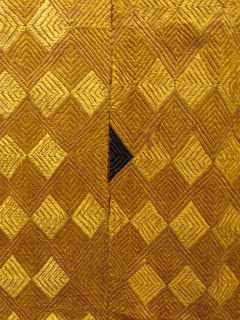I made a trip to the Brunei Gallery at SOAS in Russell Square for the first time in many, many years to see one of the most impressive exhibitions of the year thus far. The exhibition is yet another of stitched textiles which have been both inspirational and influential on my own work of late. This year I have ejoyed exhibitions of art textiles which straddle the fine divide between craft/fine art, and those of skilled but previously uncelebrated utilitarian textiles. These textiles have a more practical purpose but are now being appreciated for the artistry of their aesthetics and the merits of their technical profiency (here, here and here). This show consisting of densely embroidered Punjabi shawls falls most definately into the latter category. Baghs ('gardens') and phulkaris ('flower-work') are cotton head coverings that were made mainly in the 19th century in pre-partition Punjab mostly by groups of Sikh, Hindu and Muslim women and young girls over several months as part of their wedding trousseau or for religious ceremonies, and were kept as family heirlooms before they were then created commercially for export. The future brides grandmother would be the main embroiderer, and other family members would assist in the completion of the shawl. Baghs 'gardens' have their entire surface covered in dense embroidery. Phulkaris 'flower-work' have less embroidery with much of the cotton khaddar base visible. Baghs are therefore the most prized and most expensive of the shawls. Women carried out the cotton picking and spinning; the thread would then be hand-woven into the coarse cotton cloth known as khaddar, before being passed on to be dyed with indigo or red colours. All the embroidery was done freehand without a pattern and from the back by counting threads in darning stitch using floss silk (heer). This technique was ideal for showing most of the silk in the front as only a single thread would be caught in the back. The stitchers of these shawls and head coverings were absolutely masterful in their craft knowing exactly how to place each stitch in order to catch the maximum light generating the most beautiful, lustrous sheens on the shawls which can be seen in the pictures below especially on the gold examples. It is that same light reflective surface sheen that I have been trying to capture in my recent gold leafed spotted pieces. The shawls displayed at SOAS are from the celebrated personal collection of Karun Thakar, and as the title of the exhibition suggests the majority of shawls are decorated with floral or tree motifs which can be straightforward designs, or abstracted and mixed with geometric motifs such as squares, triangles, chevrons, diamonds and trellis-like partitions. Again as at the exhibition of Gee's Bend quilts earlier this year I was struck by the sheer variety of different patterns and designs, and how with hindsight you could liken some of the shawl designs with certain future developments and movements in modern art such as colour field painting or hard-edge abstraction. Also included in the exhibition are unusual examples of embroidered baghs that take their inspiration from figurative forms rather than flowers, and gold and silver head crowns worn by grooms on their wedding turbans. This exhibition demands a return visit so that I can further fully appreciate the dazzling array of designs and patterns of these shawls. Each shawl is stitched and embroidered with the hopes and dreams of a young bride in mind, and the possibility of a future filled with romance and motherhood. Love is sewn into every last one.
Baghs - Abstract Gardens
until 25th September
Brunei Gallery, SOAS
Russell Square
London
WC1














































































No comments:
Post a Comment